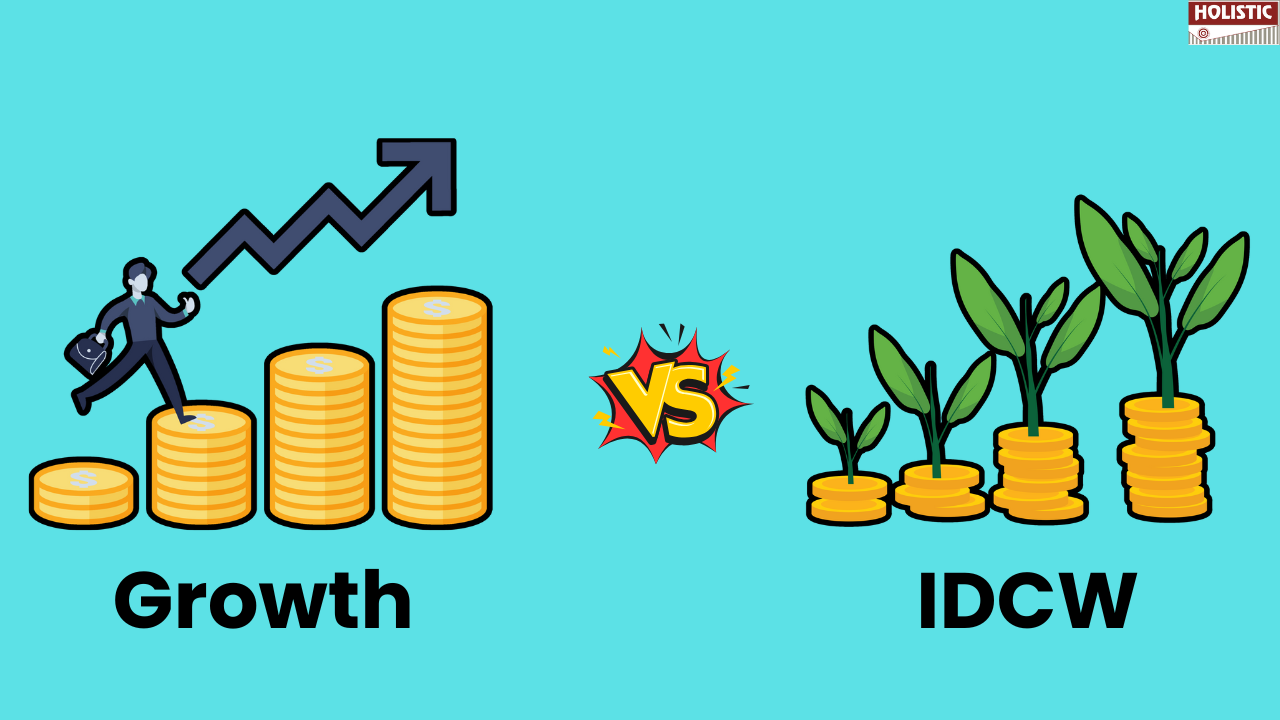Mutual fund investing has become increasingly popular among both seasoned and new investors. But with countless schemes available, how do you choose the one that aligns with your goals, risk appetite, and investment horizon?
One crucial decision investors face is choosing between the Growth option and Income Distribution cum Capital Withdrawal (IDCW) option.
Which one truly serves your financial objectives? Let’s break it down and find out which option might work best for you.
TABLE OF CONTENT
i. Growth Option: Maximizing Long-Term Wealth
ii. Key Features of the Growth Option
iii. Decoding IDCW: A Key Investment Option
iv. What are the key features of IDCW?
v. How Does IDCW Work?
vi. Key Factors to Consider When Choosing Between Growth Option and IDCW
vii. Key Differences Between Growth Option and IDCW
viii. Final Takeaway
Growth Option: Maximizing Long-Term Wealth
When investing in mutual funds, should you take regular payouts or let your money grow uninterrupted?
The Growth option in mutual funds means that the profits generated by the fund, such as capital gains or interest, are reinvested back into the fund instead of being paid out as dividends. This reinvestment helps your investment grow over time through compounding.
This decision between Growth and Income Distribution cum Capital Withdrawal (IDCW) options can significantly impact your returns and tax efficiency.
The Growth option is ideal for long-term wealth accumulation as profits are reinvested, enabling compound growth.
This compounding effect helps increase the Net Asset Value (NAV) over time, potentially building greater wealth. But is this the right strategy for you? Let’s dive deeper.
Key Features of the Growth Option
What makes the Growth Option a preferred choice for many investors? Here are its key features:
- No Regular Payouts: Unlike IDCW, this option does not provide periodic dividends. Instead, all profits are reinvested, allowing your investment to grow uninterrupted. But does this align with your financial needs?
- Capital Growth: Since earnings are reinvested, your capital has the potential to grow and compound over time. Could this strategy help you maximize long-term wealth?
- Tax Efficiency: Taxes are applicable only when you redeem your investment, potentially reducing tax liability in the short term. Would this benefit your investment strategy?
- Ideal for Long-Term Investors: The Growth Option is best suited for those with a long-term horizon, as reinvested profits continue to compound over time. Is this the right approach for your financial goals?
Understanding these features can help you determine if the Growth Option aligns with your investment strategy.
Decoding IDCW: A Key Investment Option
What exactly is IDCW? As the name implies, the Income Distribution cum Capital Withdrawal (IDCW) option allows investors to receive regular payouts and dividends.
But have you considered that with each payout, the capital invested in the scheme decreases over time? It’s important to note that the IDCW option was formerly referred to as the dividend plan.
What are the key features of IDCW?
Let’s break down the core characteristics of IDCW.
- Regular Payouts: One of IDCW’s primary advantages is its ability to offer consistent payouts and dividends. Isn’t it reassuring to have a steady income stream from your investment?
- Capital Withdrawal: These payouts may consist of both earnings and a portion of your initial investment. But have you considered that this can lead to a reduction in the fund’s net asset value (NAV) over time?
- Payout Frequency: The frequency of these payouts depends on the fund’s performance. Could it be monthly, quarterly, or annually—whichever suits your financial needs?
- Taxation: Since IDCW payouts are classified as “Income from other sources,” are you aware that they will be taxed according to your individual tax bracket?
How Does IDCW Work?
The IDCW option allows investors to receive regular income along with capital withdrawal, which leads to a reduction in the NAV. Let’s break it down with an example.
Initial Investment: Rs 100,000
NAV: Rs 40
Units Purchased: 2,500
Dividend Declared: Rs 6
Payout to Investor: 2,500 x 6 = Rs 15,000
NAV after Payout: Rs 40 – Rs 6 = Rs 34
Invested Amount After Payout: 2,500 x Rs 34 = Rs 85,000
As you can see, the payout results in a reduction in both the NAV and the invested amount.
Key Factors to Consider When Choosing Between Growth Option and IDCW
When deciding between the Growth Option and IDCW, there are several factors that investors must weigh carefully:
- Investment Goals
Are you clear about your investment goals? If you’re aiming for capital appreciation and are in it for the long haul, the Growth Option is likely a better fit. On the other hand, if you have a shorter time frame, the IDCW might suit your needs better. - Risk Appetite
What’s your risk tolerance? The IDCW option is generally less risky in the short term, while the Growth Option tends to be more volatile. Additionally, regular payouts from IDCW reduce exposure to market fluctuations, unlike the Growth Option. - Income Requirement
Do you need a steady income? If you’re not dependent on regular earnings and can invest for a longer period, the Growth Option might be ideal. But if consistent payouts are important to you, the IDCW option may be the better choice. - Tax Implications
Have you thought about the tax consequences? Taxation varies based on your tax slab, investment horizon, and payout preference. Before choosing between Growth and IDCW, it’s crucial to understand how taxes might impact your returns.
Key Differences Between Growth Option and IDCW
The table below highlights the key differences between the Growth Option and IDCW based on various parameters:
| Parameter | Growth Option | IDCW |
|---|---|---|
| Payout | No regular payouts. Earnings are received only upon redemption. | Earnings are distributed as dividends among investors. |
| Capital Appreciation | Profits and dividends are reinvested, leading to capital appreciation and compounding. | Payouts may reduce principal, impacting capital appreciation. |
| Tax Implications | Tax applies only upon redemption. | Payouts are taxed based on the investor’s tax bracket. |
| Investment Horizon | Suitable for long-term investments due to capital growth and compounding. | Ideal for retired investors who seek regular payouts. |
Final Takeaway
When choosing between IDCW and the Growth Option, it’s essential to evaluate factors such as your investment objectives, risk tolerance, and income needs. Both options offer distinct advantages and can help investors achieve different financial goals.
Ultimately, the right choice depends on your unique financial situation and long-term goals, whether you prioritize capital growth or regular income.





